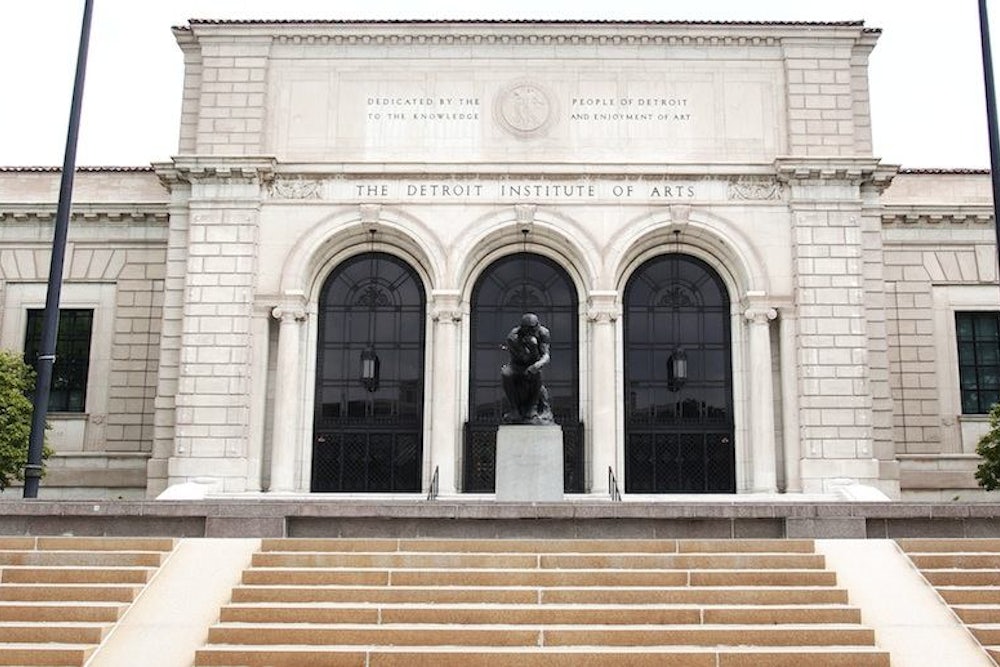In Detroit, Kevyn Orr, the bankruptcy lawyer-turned-“emergency manager” who Governor Rick Snyder parachuted in this March, has delivered a kick to a city on its knees: In late May, he announced that he is considering selling off the gems of the Detroit Institute of Arts’ (DIA) collection to pay down municipal debt. Cue the anguished protests.1
But one commentator took a different stance. “Detroit’s Van Gogh Would Be Better Off in L.A.,” wrote Virginia Postrel over at Bloomberg View. She presents her argument in utilitarian terms: “Great artworks shouldn’t be held hostage by a relatively unpopular museum in a declining region.” The more people can see the art and benefit from it, the more aggregate goodness is disseminated. She went on to write: “The cause of art would be better served if they were sold to institutions in growing cities where museum attendance is more substantial and the visual arts are more appreciated than they’ve ever been in Detroit.” Straightforward enough. But very wrong.
The provenance of an argument usually offers some clues to its merits, and this particular line of reasoning is most often deployed by Western institutions to justify holding onto their imperialist loot. In the nineteenth century, the Earl of Elgin carried off the glorious marble statues and friezes from the Athenian acropolis and installed them in the British Museum. The Greeks are still demanding the return of their cultural patrimony; the Brits continue to argue that more people can see the so-called Elgin Marbles in London. After the excavation of Machu Picchu in 1912, Yale University spent a century at loggerheads with Peru. The school agreed to return its trove of Incan artifacts in 2007, after decades of arguing that they would be better conserved and more accessible to scientists and tourists if they stayed in New Haven. This all stinks slightly of patriarchy, or at least of cultural insensitivity.
Sure, the Detroit case is a little different. The Bruegel and Matisse paintings at issue here don’t inherently belong in Michigan the way Incan bones and ceramics do in Peru. But Postrel’s argument is rooted in a similar elitism. Who’s to say that “the visual arts are more appreciated” in L.A.—or any other coastal metropolis—than in Detroit, just because those cities have more money to spend on them?
Postrel seems to owe an intellectual debt to Richard Florida, that apostle of urbanism whose 2010 book, The Great Reset, appalled critics by arguing, in so many words, that some cities deserve high culture more than others. “We need to be clear that ultimately, we can’t stop the decline of some places, and that we would be foolish to try.” Essentially, cities where the arts are already blooming deserve them, and all those other gloomy, faded backwaters don’t, as evidenced by their failure to nourish them thus far. We shouldn’t let that kind of offensive tautology justify geographic determinism or arrogance. (And as far as art museums are concerned, there are more than enough examples to disprove the theory that the arts are flourishing more in coastal cities: The museums in Indianapolis, Cleveland, and St. Louis, to name just a few, would be on any self-respecting list of the best in the country—as would the one in Detroit.)
The bottom line is that everyone deserves, and needs, access to the arts.2 Give us bread, but give us roses, too, as the saying goes. Some observers of the Detroit debate have questioned, fairly, whether the city would benefit more from the public services that the sale of its artworks could help fund—like, say, a functional police department—than from oil on canvas. But, the essential nature of the arts aside, auctioning off the city’s art could tangibly further its decline: Selling a permanent collection for any purpose other than to buy better art, as this letter to Michigan Governor Rick Snyder from the Association of Art Museum Directors makes clear, could destroy DIA’s credibility with donors and art collectors beyond hope of recovery. It seems shortsighted to salt the earth of one of Detroit’s most important cultural institutions for a sum that wouldn’t come close to covering its more than $15 billion debt.
Before I wrap this up, I’ll admit to a little bias. My mother works in a museum, and I used to go there every day after school. When the place closed down in the evenings, I’d have it to myself, and I spent years doing my homework under paintings. With those memories in mind, I argue that DIA’s masterpieces are better situated in Detroit than at the end of a long, full hallway at the Met. Every person should have the chance, not just to see art, but to live down the street from it: to go back to the same pieces again and again. How many times have I stood in front of my favorite painting at the museum I grew up in, a dreamlike image by a local artist named Edwin Romanzo Elmer? Years later, when I close my eyes, I can still see it.
Nora Caplan-Bricker is an assistant editor at The New Republic. Follow her on Twitter @ncaplanbricker.
"Art for the public is not interim, fungible or liquid,” declared Metropolitan Museum of Art director Thomas Campbell. “It’s unspeakable,” a city resident told the Detroit Free Press. “The art belongs to all of us, even if the city technically owns it.” DIA president Graham Beal, who is credited with reviving the museum into one of the nation’s best, called the proposal “sickening.”
If you doubt this, read New Republic Literary Editor Leon Wieseltier’s impassioned defense of the humanities here.
